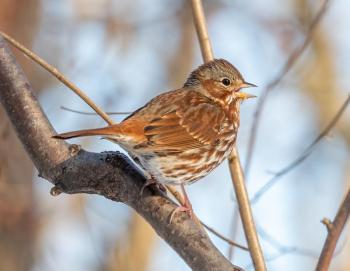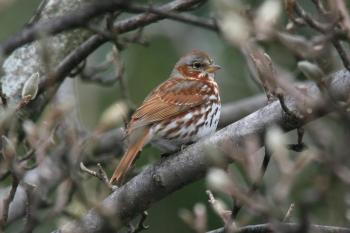The Revolutionary War Connection to the Foxy Finch
For much of last week, we were fortunate that our backyard was blessed with the presence of one of our largest and brightest colored sparrows, the fox sparrow. While there are a number of different forms in western North America, we here in the eastern U.S. have the one that is the most reddish, hence the unofficial name sometimes given to it, “red fox sparrow.” The red is not bright like a cardinal or a scarlet tanager; it’s more the color of—you guessed it—a fox or more specifically, a red fox (as opposed to other fox species, such as the gray fox or the Arctic fox).
Early ornithologists had other names for the species, “foxy finch” and “ferruginous finch” among them. The scientific name, Passerella iliaca, was coined by a German biologist who described the species in 1786. He is said to have received the specimen from a Hessian officer who was apparently one of the 30,000 or so German soldiers who were hired by the British Army to bolster their numbers during the American Revolutionary War period. The species name of “iliaca” is similar to that of the redwing, a European thrush (we wrote about one that showed up here in Maine) that is named Turdus iliacus. Perhaps the German biologist noted a general, vague resemblance between the two species?
While the bird’s name history has connections to Europe, make no mistake: this is a distinctly North American species. The “red” fox sparrow breeds from Alaska to Newfoundland and Labrador and south to the Maritimes of Canada. It was discovered breeding in northern Maine for the first time in the 1980s and now is an uncommon but regular breeder across parts of northern and western Maine. More recently, birds have been found in summer also in northern New Hampshire, Vermont, and in the Adirondacks of New York. This southerly range expansion is especially perplexing because all available summer and winter data show a significant decline in numbers across most of the range over the last decade.
Other forms of the fox sparrow occur across the Rocky Mountain and the Pacific Coast, some of which may one day be officially considered to be distinct species rather than forms or subspecies of the fox sparrow.
Here in the eastern U.S., fox sparrows winter in greatest numbers from the mid-Atlantic states south to the Gulf Coast states. A small but increasing number winter as far north as coastal Maine. They begin migrating north in March and are one of the first spring migrants we may see in our area. Although the single bird we had in our yard last week has moved on, birders have been reporting small numbers (usually one or two in a single location) from across the state this week as well.
Fox sparrows are rather famous for their rich and melodious songs. In the 1800s, people in some parts of the U.S. regularly captured and kept caged fox sparrows because of their beautiful voices. Thankfully, this is no longer allowed. Today, we can enjoy the beautiful songs from fox sparrows singing outside in our backyards and parks as they migrate through in spring. But they won’t be here much longer, most migrate through quickly and are gone by mid-April.
Enjoy them while you can!
Jeffrey V. Wells, Ph.D., is a Fellow of the Cornell Lab of Ornithology and Vice President of Boreal Conservation for National Audubon. Dr. Wells is one of the nation's leading bird experts and conservation biologists. He is a coauthor of the seminal “Birds of Maine” book and author of the “Birder’s Conservation Handbook.” His grandfather, the late John Chase, was a columnist for the Boothbay Register for many years. Allison Childs Wells, formerly of the Cornell Lab of Ornithology, is a senior director at the Natural Resources Council of Maine, a nonprofit membership organization working statewide to protect the nature of Maine. Both are widely published natural history writers and are the authors of the popular books, “Maine’s Favorite Birds” (Tilbury House) and “Birds of Aruba, Bonaire, and Curaçao: A Site and Field Guide,” (Cornell University Press).






























